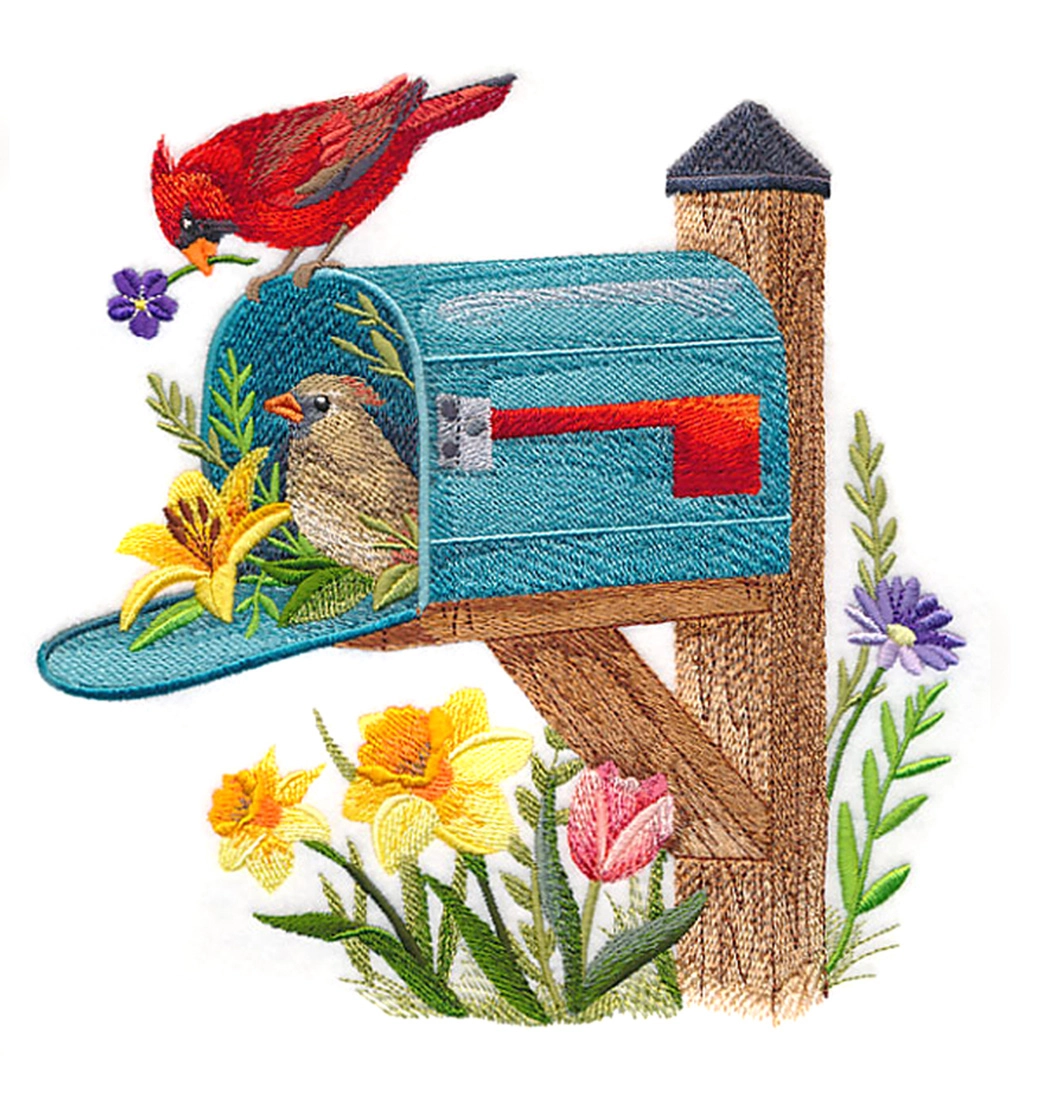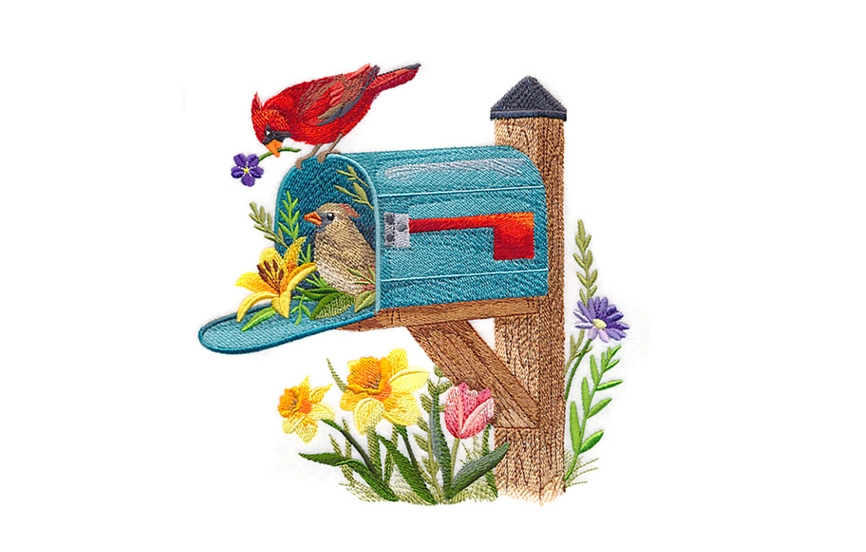When it comes to solid-color, inexpensive fabrics, broadcloth is the king. It's similar to quilter's cotton in weight and in texture -- although you may find that broadcloth is a little rougher to the touch.
Broadcloth is a light weight fabric, and that means it's often made into easy-breezy skirts and shirts to wear during hot summery months. And, its durability makes it nice for quilt tops and blocks too. All that, plus broadcloth's low price, makes it an appealing fabric.
But because broadcloth is so light, it's a sensitive fabric when it comes to embroidering designs onto it. When we embroider on it, we're adding weight and tension with the stitches. Broadcloth is a bit on the "wimpy" side, so if we add too much weight and tension, or don't provide the right support with stabilizer, then broadcloth will likely pucker. However, if you keep just a few things in mind -- choosing the right designs and stabilizer -- then your broadcloth projects will be trouble-free. Read on for more details!
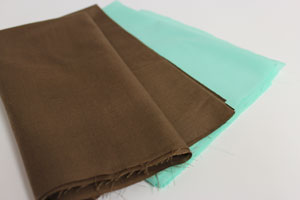
Getting to know broadcloth
Broadcloth has an interesting history and manufacturing process. During medieval times, it was usually made from wool into a dense multi-purpose cloth. Over time, other fibers have been incorporated into broadcloth's production, including silk and polyester. Currently broadcloth is most commonly a blend of polyester and cotton.
The textile process gives broadcloth a soft, smooth feeling and silky sheen. It's available in a wide variety of colors, and is most often used in quilting, draperies, and summery lightweight garments, such as shirts and skirts.
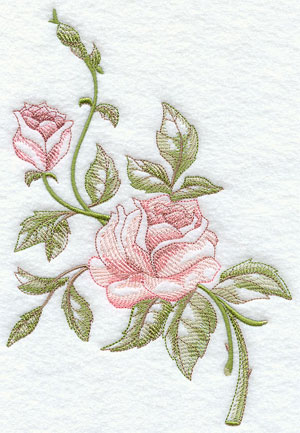
Choosing the right designs:
Although broadcloth is tightly woven, it's a lightweight and weak fabric. When choosing designs for a project with broadcloth, look for designs that are light and airy with open spaces. Avoid solid-stitched complex designs with large filled-in areas.
The design on the right is one that would be wonderful on broadcloth. Note the open areas in the buds and leaves, and the light stitching. Also, the design is flowing -- not a solidly filled in circle, square, or rectangle. This means that the fabric will drape well.
Redwork, Bluework, Blackwork, toile, and most light-stitching vintage designs are a great choice for broadcloth. Other good choices include borders and corners (ones with open areas, not solid rectangles), and designs with simple fills. Running stitches, light fills, and some satin stitches are ok, but designs that have layering, shading, and highlighting will ultimately be too heavy for broadcloth.
Choosing your needle: Most embroiderers will use an embroidery needle on just about every project, and doing so will usually get fine results. And, it makes sense: it's an embroidery machine, therefore it needs an embroidery needle.
However, we love using a 75/11 sharp sewing needle in most of our projects, including when stitching on broadcloth. A sharp needle has a finer point than an embroidery needle, so it makes smaller holes in the fabric, and the stitches are nice and crisp.
Either an embroidery needle or a sharp sewing needle will be fine on broadcloth, but if you notice that the holes in your fabric are large (this happens with low-quality broadcloth, which has a looser weave than higher-quality broadcloth), or if you're finding that your stitches are a bit fuzzy and not quite as crisp as you'd like, then try a sharp sewing needle instead.
Caring for the fabric: Pre-wash the fabric to shrink it. It's a cotton polyester blend, so it might shrink a little, or it might shrink a lot -- but it will shrink. And, after you've embroidered the fabric, care for it according to the manufacturer's recommendations (grab those recommendations from the bolt at the store before you leave). All of the broadcloth that we found had labels that recommended washing in warm water, and tumbling dry on low.
Choosing the right stabilizer: For light and airy designs, like Redwork, Bluework, or toile, use a lightweight cutaway like Sulky Soft 'N Sheer or Floriani's No Show Mesh. For the simplest of Redwork or Bluework designs, you may also use a tear-away stabilizer; however, if you see any looping of thread or stitches landing where they're not intended to, use a cutaway stabilizer.
For designs that are more complex than Redwork, Bluework, or toile, use a medium-weight (2.5 ounce) cutaway stabilizer. Hoop the broadcloth with the stabilizer firmly. Do not hoop the stabilizer only, or "float" a piece of stabilizer under the hoop; doing so will cause the needle to become dull, resulting in larger holes in your fabric.
I embroidered several different designs on broadcloth to demonstrate the above techniques and recommendations. Keep reading for more information!
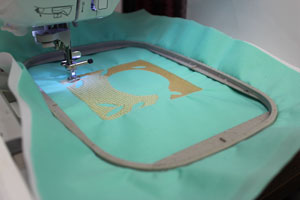
Embroidering on Broadcloth
First, I'll demonstrate what happens when stitching a complex design onto broadcloth.
Earlier I recommended a light and open design, not a solid block of stitches. So I chose the Tea of Tranquility design, which is a type of design that would definitely NOT work well on broadcloth. Take a look at what happened:
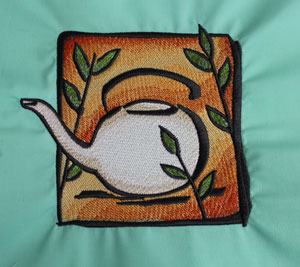
You can see that the broadcloth is puckering around the edges of the design. The design has layering and highlighting, and is a solid square of stitching. The weight and tension of the stitches are skewing the fabric fibers, resulting in puckering.
Also, take a look at the bottom edge of the design. Can you see the broadcloth peeking between the orange fill and the black border? Even though I had the fabric hooped with the stabilizer firmly, I still had "gapping" in the stitchout. This occurs when the fabric is shifting and skewing in the hoop under the weight and tension of the stitches.
The Tea of Tranquility design is a much better choice for stitching onto canvas, duck cloth, denim, and medium to heavy weight decorator fabrics. This type of design isn't going to work on lightweight fabrics like broadcloth.
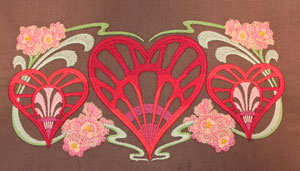
This design is the Art Nouveau Heart Trio, and it turned out beautifully on the broadcloth. I hooped it with a medium-weight (2.5 ounce) cutaway stabilizer. And, because I believe strongly in the power and magic of spray adhesive, I added a quick shot to the stabilizer, then smoothed the fabric on top, before I hooped both together. Spray adhesive (I use KK100) does a great job keeping the fabric and stabilizer together, nice and tight, to prevent shifting, gapping, and puckering.
Here's an interesting thing that I noticed: The Tea of Tranquility design has about 53,000 stitches, and didn't work well on broadcloth. The Art Nouveau Heart Trio has 54,000 stitches -- and it does work well on broadcloth.
Oftentimes I hear questions about "how many stitches can be embroidered onto quilter's cotton," or "how many pieces of stabilizer for a design that has xxxx number of stitches." And sometimes I wish there were a "hard and fast" rule, or a chart that we could reference to make sure that we get the right fabric and stabilizer combination, each and every time.
But as demonstrated above, it isn't that simple. The Art Nouveau Heart Trio design has more stitches than the Tea of Tranquility design, but it's a different shape. It's rectangular instead of square, with open areas inside the heart. The flowers are complex, and if the design was a solid block of those flowers, then it wouldn't work. But they're spread out, and the rest of the design contains colors with little or no shading.
In this case, the shape of the design, and the open areas, make all the difference in the world when stitching onto broadcloth.
(And if you're wondering about the answer to the question of how many pieces of stabilizer per xxxx number of stitches? The answer is "one piece of stabilizer." There are different schools of thought about this, but in my experience, using more than one piece of stabilizer dulls the needle, which makes larger holes in the fabric, and ultimately results in a heavy stitchout that doesn't drape very well. Hoop fabric with one piece of stabilizer for the best results.)

With its sleek finish and array of solid colors, broadcloth is beautifully paired with Redwork designs. These one-color designs are primarily composed of running stitches, and in a few special cases satin stitches are added for extra dimension and fun.
Use broadcloth in a variety of projects, from table linens to quilted wall hangings to cozy quilts. And, if you construct garments, broadcloth is wonderful for skirts and shirts.

